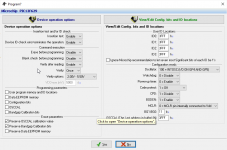modem7
10k Member
I also have an AT-class Key Tronic keyboard (a different model to yours) that is similar; no switch soldered on. When I added a suitable switch, it made no difference. It appears that at some point, Key Tronic decided to drop support for the XT protocol, by removing the XT related code in the keyboard's ROM, and removing the XT-AT switch (but kept using the same case).I found this keyboard: key tronics E03602 EL FR (french one).
It seems XT compatible, but these are not switches on the second photo. Instead there are 3 holes. Do I need to solder switches myself? For XT compatibility I have to connect the 3 of them? It is not clear to me how to configure it.
Your Key Tronic keyboard may be the same (i.e. adding a switch does nothing).
If you want to try adding a switch, you would need to pull the keyboard apart to investigate further (e.g. determine size restrictions for switch, holes for switch pins, ...)
The white outline on the PCB suggests a slide type of switch. An example (repeat: example) is shown at [here].
( BTW. The 'PCs and clones' forum would have been a better place for your post. )

